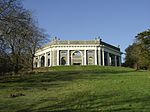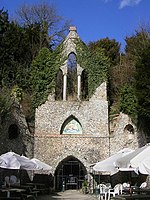West Wycombe railway station
West Wycombe railway station was a railway station that served the village of West Wycombe, Buckinghamshire Situated about 1⁄2 mile (0.80 km) east of the village the station opened in 1862 and closed in 1958. Minutes of the Wycombe Railway state that construction of West Wycombe station in 1862 cost £430 8s 8d, equivalent to £42,731 in 2021, with additional general works at £417 8s 8d, equivalent to £41,441 in 2021.In the late 1980s, the then operator of the Chiltern Lines Network SouthEast suggested reopening West Wycombe station in order to ease the peak hour congestion at the main High Wycombe station. However, no detailed plans were ever published, and there has been no further suggestion of reopening the station by the current operator, the Arriva owned Chiltern Railways. Chiltern Railways has invested heavily in both infrastructure and rolling stock for the Chiltern group of lines.
Excerpt from the Wikipedia article West Wycombe railway station (License: CC BY-SA 3.0, Authors).West Wycombe railway station
West Wycombe Road,
Geographical coordinates (GPS) Address Nearby Places Show on map
Geographical coordinates (GPS)
| Latitude | Longitude |
|---|---|
| N 51.643 ° | E -0.7903 ° |
Address
West Wycombe Road
West Wycombe Road
HP12 4AH , West Wycombe
England, United Kingdom
Open on Google Maps










